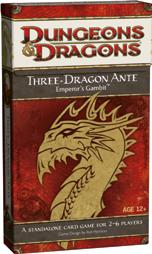![]()
Oh God Dragons!!!
 THREE_DRAGON ANTE EMPEROR’S GAMBIT
THREE_DRAGON ANTE EMPEROR’S GAMBIT
Designer: Rob Heinsoo
Illustrator: Craig Phillips
Publisher: Wizards of the Coast
Price: $14.99
THE HISTORY
Three-Dragon Ante was designed by Wizards of the Coast as the typical or traditional tavern card game for virtually any Dungeons & Dragons setting. The first version was put out 2005 as a supplement for D&D v3.5. It was pretty popular for a time and I know I enjoyed playing a few hands, I just wish we could have found an old copy (you’ll see why in a bit). Now that Fourth Edition has rolled around, Wizards changed a fair number of the dragons, so a new version was in order. Thinking ahead, instead of just mixing the new and the old, WotC made a brand new seventy card deck and gave it a subtitle, Emperor’s Gambit. This plays as a variant edition to the original, much like Draw vs. Stud in poker. In an even better move, WotC did not change the backs or the rules, so the two decks are 100% compatible with no overlap or copied cards, though one of the powers from the original is repeated.
THE GAMEPLAY
The game starts with each player getting gold equal to ten times the number of players then being dealt six cards. These cards will each represent a dragon or mortal and have a number that represents their strength ranging from one to thirteen with the highest concentration at five. Each player than antes one of the cards in his hand, each player then puts gold equal to the highest ante card into the stakes and the player with the highest untied ante gets to start the first round of the gambit.
A round of play consists of each player in a clockwise order playing a card from their hand. The reason it is best to go first is that each card has a power, and powers only trigger if the player before you played a card of equal or higher strength than yours, by going first your card will always trigger. A gambit consists of three rounds, the person who played the strongest card in the previous round goes first in the next and the person with the strongest flight, that’s the group of cards you played, wins the gambit and the stakes. There are two types of special flights: color and strength. A color flight has three dragons of the same color and a strength flight is three of the same strength. The former makes your opponents pay you gold directly and the latter lets you steal gold from the stakes and cards from the ante.
After a gambit, you discard all played and anted cards then each player is dealt two new cards and we go to the ante phase again. Obviously this means that you will run out of cards eventually. The game has two ways to deal with that, a number of card powers will put more cards into your hand, either by drawing or taking from elsewhere, and when you are down to one or fewer cards you have to buy more by paying gold into the stakes and drawing up to four cards into your hand. The game itself ends when after a gambit any player has no more gold. A player can go into debt during a gambit, the leading player usually makes any payments the broke player would make, at the end of the gambit debts are paid off if possible if not the game is obviously over.
The powers of the Aligned Dragons usually either get you more money or more cards, except for two the Shadow and Purple. The Shadow snags a random card from and opponent and the Purple has you draw a card then put a card from your hand into the ante. The Mortals and Unaligned Dragons on the other hand, have wildly varied effects, from simple effects similar to the other Dragons to extending the gambit an extra round to triggering the powers of all mortals in your flight.
There is one truly new and different introduction from Emperor’s Gambit that the original did not have, ante effects. Five of the seventy cards have an extra power that triggers when they are in the ante. One of these copies a power from the previous game, the other four are brand new effects such as making high strength cards (ten or higher) always trigger or making the round leader pay two gold to each opponent at the start of the round.
THE VERDICT
We’ve played a few games here, ranging from 3-5 players and have had a total blast. It’s easy enough that anybody who understands the basic concepts of addition and matching can play it effectively but complex enough that you actually have to form strategy while playing and usually reform it on the fly. The difference in player numbers also makes things go differently as well, with more players, the Mortals come up much more often while with fewer players you can usually steal enough gold to come out victorious. Right now, my only disappointment is that I can’t find a copy of the original to try out some of the theme decks presented in the back of the rules book. 5 of 5 stars, I had plenty of fun with people who normally wouldn’t even give this type of game a second look.







3 Comments
Hmmm, I wouldn’t mind getting my hands on this.
WOW this is on the top of my wishlist.
(Right in front of some more miniatures…)
Just wondering how you managed to get your hand on such high quality digital versions of the cards for this review.